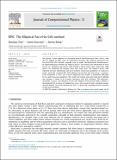Files in this item
EPIC : the Elliptical Parcel-In-Cell method
Item metadata
| dc.contributor.author | Frey, Matthias | |
| dc.contributor.author | Dritschel, David | |
| dc.contributor.author | Böing, Steven | |
| dc.date.accessioned | 2022-07-26T16:30:06Z | |
| dc.date.available | 2022-07-26T16:30:06Z | |
| dc.date.issued | 2022 | |
| dc.identifier | 280604462 | |
| dc.identifier | 3d298e89-c57a-48fe-967b-d92175c9faf5 | |
| dc.identifier | 85133608603 | |
| dc.identifier.citation | Frey , M , Dritschel , D & Böing , S 2022 , ' EPIC : the Elliptical Parcel-In-Cell method ' , Journal of Computational Physics: X , vol. 14 , 100109 . https://doi.org/10.1016/j.jcpx.2022.100109 | en |
| dc.identifier.issn | 2590-0552 | |
| dc.identifier.other | RIS: urn:D2C52DDC952E0CC3C94F811D57C73A5C | |
| dc.identifier.other | ORCID: /0000-0001-6489-3395/work/116597618 | |
| dc.identifier.other | ORCID: /0000-0002-7842-0051/work/116598374 | |
| dc.identifier.uri | https://hdl.handle.net/10023/25716 | |
| dc.description | Funding: This research is supported by the UK Engineering and Physical Sciences Research Council (grant numbers EP/T025301/1 and EP/T025409/1 ). | en |
| dc.description.abstract | We present a novel approach to simulating general two-dimensional flows, which could also be applied to other areas of continuum mechanics. The approach generalises the Particle-In-Cell (PIC) method, originally used to model two-dimensional hydrodynamics, by representing fluid elements by elliptical parcels. The rotation and deformation of these parcels are calculated, and parcels split beyond a critical aspect ratio. Conversely, small parcels are eliminated by merging them with larger ones. The elliptical parcels well represent the flow deformation and have excellent conservation properties. In contrast to earlier work that combined PIC with elliptical parcels that split and merge, a vorticity-based framework is used, and accurate integration over ellipses is performed efficiently by two-point Gaussian quadrature. The small-scale mixing associated with parcel splitting and merging is shown to be strongly convergent with grid resolution. The robustness, versatility, accuracy and efficiency of the new Elliptical Parcel-In-Cell (EPIC) method is demonstrated for a variety of standard test cases, and compared with a standard pseudo-spectral method. The results indicate that EPIC is a promising, Lagrangian-based alternative to grid-based methods. | |
| dc.format.extent | 43 | |
| dc.format.extent | 5121399 | |
| dc.language.iso | eng | |
| dc.relation.ispartof | Journal of Computational Physics: X | en |
| dc.subject | Density stratified flows | en |
| dc.subject | Elliptical parcels | en |
| dc.subject | Lagrangian methods | en |
| dc.subject | PIC | en |
| dc.subject | Turbulent flows | en |
| dc.subject | QA75 Electronic computers. Computer science | en |
| dc.subject | QC Physics | en |
| dc.subject | DAS | en |
| dc.subject.lcc | QA75 | en |
| dc.subject.lcc | QC | en |
| dc.title | EPIC : the Elliptical Parcel-In-Cell method | en |
| dc.type | Journal article | en |
| dc.contributor.sponsor | EPSRC | en |
| dc.contributor.institution | University of St Andrews. Applied Mathematics | en |
| dc.contributor.institution | University of St Andrews. Marine Alliance for Science & Technology Scotland | en |
| dc.contributor.institution | University of St Andrews. Scottish Oceans Institute | en |
| dc.identifier.doi | https://doi.org/10.1016/j.jcpx.2022.100109 | |
| dc.description.status | Peer reviewed | en |
| dc.identifier.grantnumber | EP/T025301/1 | en |
This item appears in the following Collection(s)
Items in the St Andrews Research Repository are protected by copyright, with all rights reserved, unless otherwise indicated.

